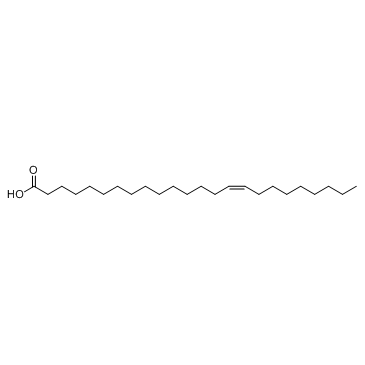Nervonic acid

Nervonic acid structure
|
Common Name | Nervonic acid | ||
|---|---|---|---|---|
| CAS Number | 506-37-6 | Molecular Weight | 366.621 | |
| Density | 0.9±0.1 g/cm3 | Boiling Point | 479.2±14.0 °C at 760 mmHg | |
| Molecular Formula | C24H46O2 | Melting Point | 42-43 °C(lit.) | |
| MSDS | Chinese USA | Flash Point | 375.8±15.2 °C | |
| Symbol |

GHS07 |
Signal Word | Warning | |
|
HMDB: a knowledgebase for the human metabolome.
Nucleic Acids Res. 37(Database issue) , D603-10, (2009) The Human Metabolome Database (HMDB, http://www.hmdb.ca) is a richly annotated resource that is designed to address the broad needs of biochemists, clinical chemists, physicians, medical geneticists, nutritionists and members of the metabolomics community. Si... |
|
|
The human serum metabolome.
PLoS ONE 6(2) , e16957, (2011) Continuing improvements in analytical technology along with an increased interest in performing comprehensive, quantitative metabolic profiling, is leading to increased interest pressures within the metabolomics community to develop centralized metabolite ref... |
|
|
Development and application of a comparative fatty acid analysis method to investigate voriconazole-induced hepatotoxicity.
Clin. Chim. Acta 438 , 126-34, (2014) As fatty acids play an important role in biological regulation, the profiling of fatty acid expression has been used to discover various disease markers and to understand disease mechanisms. This study developed an effective and accurate comparative fatty aci... |
|
|
An efficient and economical MTT assay for determining the antioxidant activity of plant natural product extracts and pure compounds.
J. Nat. Prod. 73 , 1193-5, (2010) Antioxidants scavenge free radicals, singlet oxygen, and electrons in cellular redox reactions. The yellow MTT [3-(4,5-dimethylthiazole-2-yl)-2,5-diphenyltetrazolium bromide] is reduced to a purple formazan by mitochondrial enzymes. NADPH is the basis of esta... |
|
|
Lipidomics reveals a remarkable diversity of lipids in human plasma.
J. Lipid Res. 51(11) , 3299-305, (2010) The focus of the present study was to define the human plasma lipidome and to establish novel analytical methodologies to quantify the large spectrum of plasma lipids. Partial lipid analysis is now a regular part of every patient's blood test and physicians r... |
|
|
GC-EI-MS analysis of fatty acid composition in brain and serum of twitcher mouse.
Lipids 49(11) , 1115-25, (2014) Globoid cell leukodystrophy or Krabbe disease is an inherited autosomal recessive disorder caused by mutations in the galactosylceramidase gene. The objective of the study was to present information about the fatty acid (FA) composition of the brain and serum... |
|
|
Serum free fatty acids level in senile cataract.
J. Am. Coll. Nutr. 33(5) , 406-11, (2014) To evaluate and compare the levels of free fatty acids between senile cataract patients and normal controls.Fifty consecutive patients with newly diagnosed senile cataract and 50 age- and gender-matched controls were evaluated. Subjects/patients were randomiz... |
|
|
Lipophilic components of different therapeutic mud species.
J. Altern. Complement. Med. 13(10) , 1115-8, (2007) Mud, which contains organic and mineral ingredients, is used for the treatment of several degenerative diseases. It has been proposed that beneficial effects of mud are not only related to its local thermal effects, but also to its chemical components. Unlike... |
|
|
The source of long-chain PUFA in formula supplements does not affect the fatty acid composition of plasma lipids in full-term infants.
J. Nutr. 134(4) , 868-73, (2004) Supplementation of formulas for full-term infants with long-chain (LC) PUFA [arachidonic acid (AA) and docosahexaenoic acid (DHA)] at levels resembling human milk is recommended because they provide biochemical and functional benefits to the neonate. The obje... |
|
|
Dietary patterns and blood fatty acid composition in children with attention-deficit hyperactivity disorder in Taiwan.
J. Nutr. Biochem. 15(8) , 467-72, (2004) Nutritional factors may be relative to attention-deficit hyperactive disorder (ADHD), although the pathogenic mechanism is still unknown. Based on the work of others, we hypothesized that children with ADHD have altered dietary patterns and fatty acid metabol... |